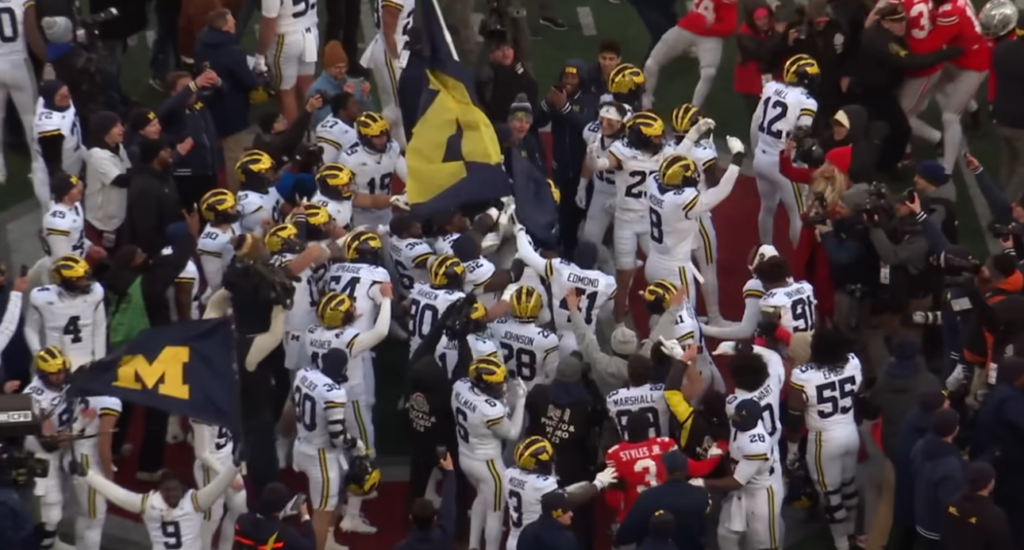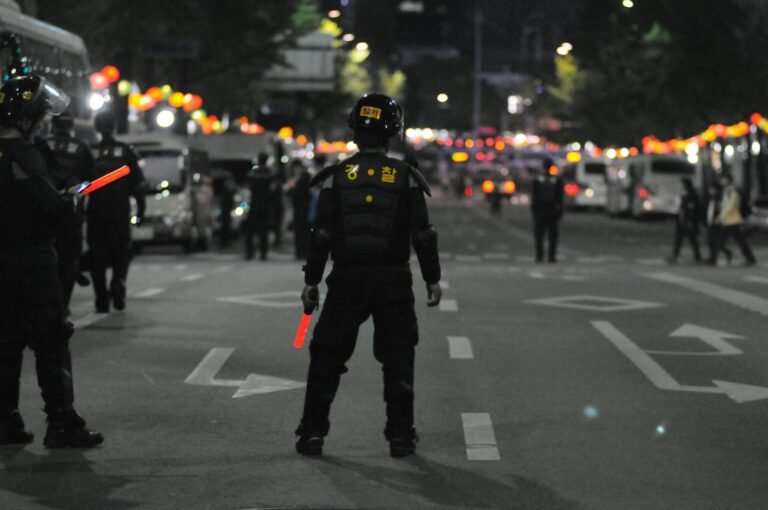
Commentary
The 120th edition of the Michigan-Ohio State rivalry delivered one of the most thrilling finishes in recent memory, with Michigan stunning the No. 2-ranked Buckeyes in a 13-10 victory. The win not only preserved Michigan’s pride after a season of ups and downs, but also extended their winning streak in the rivalry to four straight games. Yet, in the aftermath of this dramatic contest, something far uglier than the play on the field emerged—an all-too-familiar sight in today’s sports culture: a postgame brawl.
After the final whistle, tensions flared when a Michigan player attempted to plant a Wolverines banner on Ohio State’s midfield logo, a move that sparked pushing, shoving, and eventually punches from players on both teams. What followed was an embarrassing spectacle of violence, with security and police scrambling to separate the players, and pepper spray deployed to restore order.
For what should have been a victory moment—an underdog win in one of the most storied rivalries in college football history—the postgame brawl overshadowed the victory. Television cameras caught players coughing and wiping their eyes from the effects of the spray, a jarring image for anyone who values sportsmanship. Michigan running back Kalel Mullings, a participant in the game, summed it up best when he called the brawl “bad for the sport” and “classless.”
And it is classless.
For a sport that prides itself on instilling values like discipline, teamwork, and leadership, this violent eruption at Ohio Stadium raises serious questions about what we’re teaching these young men. These athletes are supposed to represent not only their teams but their universities—institutions that are viewed as the pinnacle of higher education and the American collegiate experience. When they behave in such a disgraceful manner, what message does that send to the rest of the nation, particularly to the parents of future students?
The most disturbing part of this entire incident isn’t the punches thrown or the pushing on the field, it’s the glaring lack of self-control. What are we teaching these athletes about how to handle disappointment, conflict, and rivalry? In a game that saw both teams playing with everything on the line for four quarters, the only thing that should have mattered at the final whistle was the score—and for Ohio State, the realization that they had lost.
The actions of these players are not only embarrassing to their programs but reflect poorly on their universities and the broader culture of college sports. Michigan and Ohio State are two of the most prestigious academic institutions in the country, known for producing scholars and leaders who go on to shape the world. This is the environment these athletes are supposed to be developing in. When they act out in such a public, chaotic manner, it undermines the values these schools claim to uphold. The negative fallout from this brawl should be a wake-up call to the coaches, administrators, and fans who look the other way when these young men indulge in toxic behavior.
What happened on that field goes beyond the game. The violence, the lack of sportsmanship, and the pride that led to it all raise a fundamental question: What kind of example are we setting for the next generation? We claim to value the development of these students into well-rounded individuals, but the aftermath of this fight suggests otherwise. This incident isn’t just about one game or two teams—it’s a reflection of a larger culture of entitlement and aggression that can fester when athletes are placed on a pedestal, and their every action is excused because of their status as competitors.
Ohio State head coach Ryan Day, while acknowledging his players’ frustration, stated, “There are some prideful guys on the team who weren’t just going to let that happen.” While understandable, this mentality only contributes to the toxic environment. Losing is part of the game. If anything, it should be used as an opportunity for growth and maturity, not as a springboard for an embarrassing display of immaturity. Day’s response, while pragmatic, still misses the bigger point—how these athletes handle defeat, adversity, and pressure is a reflection of who they are as people and how they will lead in the future.
It’s time for both Michigan and Ohio State to step up—not just in their games, but in their approach to shaping character. We are asking more from these student-athletes than just great plays on the field. We are asking them to be leaders, role models, and ambassadors for their schools, and for the values these universities claim to stand for. Good sportsmanship, discipline, and respect for the opponent should be as important as winning.
In the end, the Michigan-Ohio State rivalry is one of the best and most storied in all of sports, and there is so much to celebrate about the passion these teams bring to the field. But that passion should never translate into mindless violence or disrespect. It’s time to get a life. It’s time to show these young men that there’s more to life than just winning a football game—and that how you handle defeat, how you treat your opponent, and how you represent your team matters far more than anything that happens after the final whistle.
So to the brawlers in Ohio Stadium and beyond, here’s a message: ‘Get a Life’. You’re not just representing your team—you’re representing your school, your community, and your future. Live up to that responsibility.


